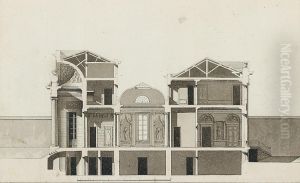Jean-Charles Krafft Paintings
Jean-Charles Krafft, born in 1764, was a figure of considerable influence in the realm of architectural design and publishing during the late 18th and early 19th centuries. Despite not being a household name today, Krafft's contributions to the documentation and dissemination of architectural knowledge have left a lasting legacy, particularly through his detailed illustrations and pattern books which catered to the burgeoning interest in neoclassical architecture.
Krafft's career was marked by a deep engagement with the architectural trends of his time, reflecting the broader European shift towards classical antiquity for inspiration. This period, often referred to as the Neoclassical era, saw architects and designers drawing heavily from the art and architecture of ancient Greece and Rome. Krafft, through his detailed engravings and publications, played a crucial role in documenting existing architectural marvels and proposing new designs that adhered to neoclassical principles. His works were not only artistic but also educational, serving as valuable resources for architects, craftsmen, and builders across Europe.
One of Krafft's most significant contributions was his detailed studies and publications of house designs, which effectively bridged the gap between high art and practical construction. His pattern books and architectural guides were highly sought after, as they provided practical examples of the neoclassical style that could be adapted and adopted by local builders and architects for their projects. These publications were instrumental in spreading the neoclassical aesthetic beyond the confines of major urban centers and into the provinces, thereby influencing the architectural landscape of Europe in a profound and lasting manner.
Krafft's legacy is also marked by his emphasis on the educational value of his work. He was a pioneer in the use of publications to disseminate architectural knowledge, understanding the power of the printed page to reach a wider audience than traditional means of architectural education could. His approach was democratic, aiming to elevate the taste and understanding of architecture among the general populace and professionals alike. Through his efforts, Krafft contributed to the formation of a more educated and engaged public, interested in the architectural heritage and future of their surroundings.
Jean-Charles Krafft passed away in 1833, leaving behind a body of work that continues to be of interest to historians, architects, and lovers of neoclassical design. His publications remain valuable resources for those studying the evolution of architectural thought and practice in the late 18th and early 19th centuries. Through his meticulous documentation and creative designs, Krafft played a pivotal role in the dissemination of neoclassical architectural principles, making him a figure of enduring significance in the history of architecture.
